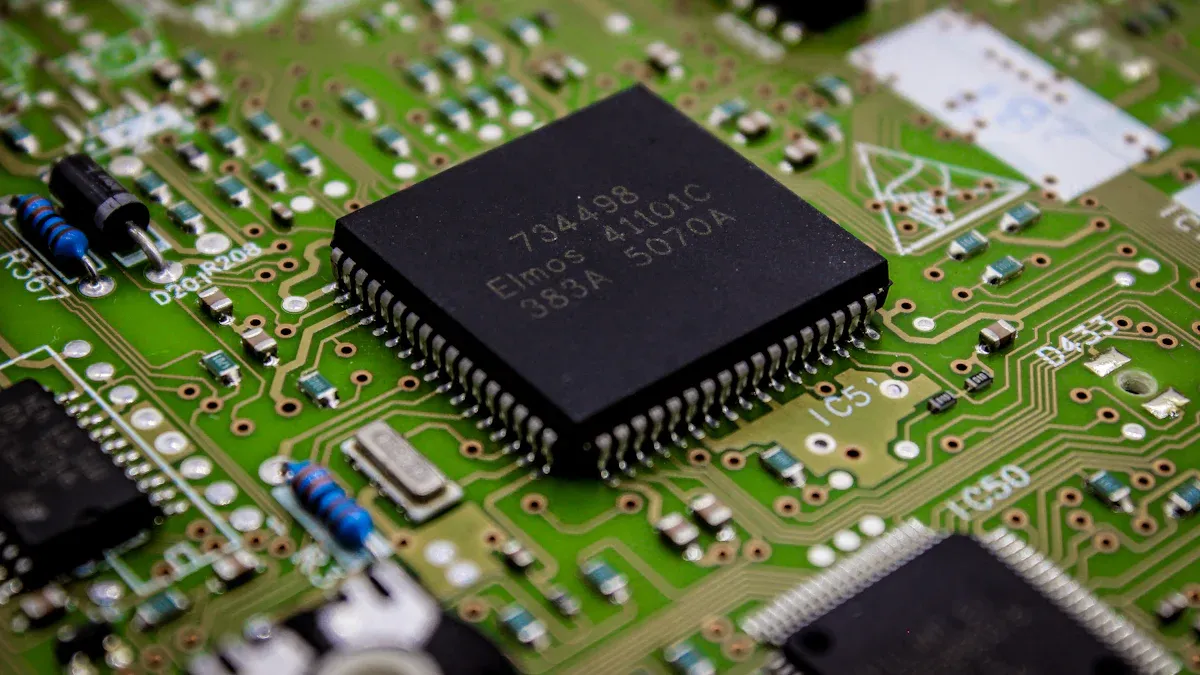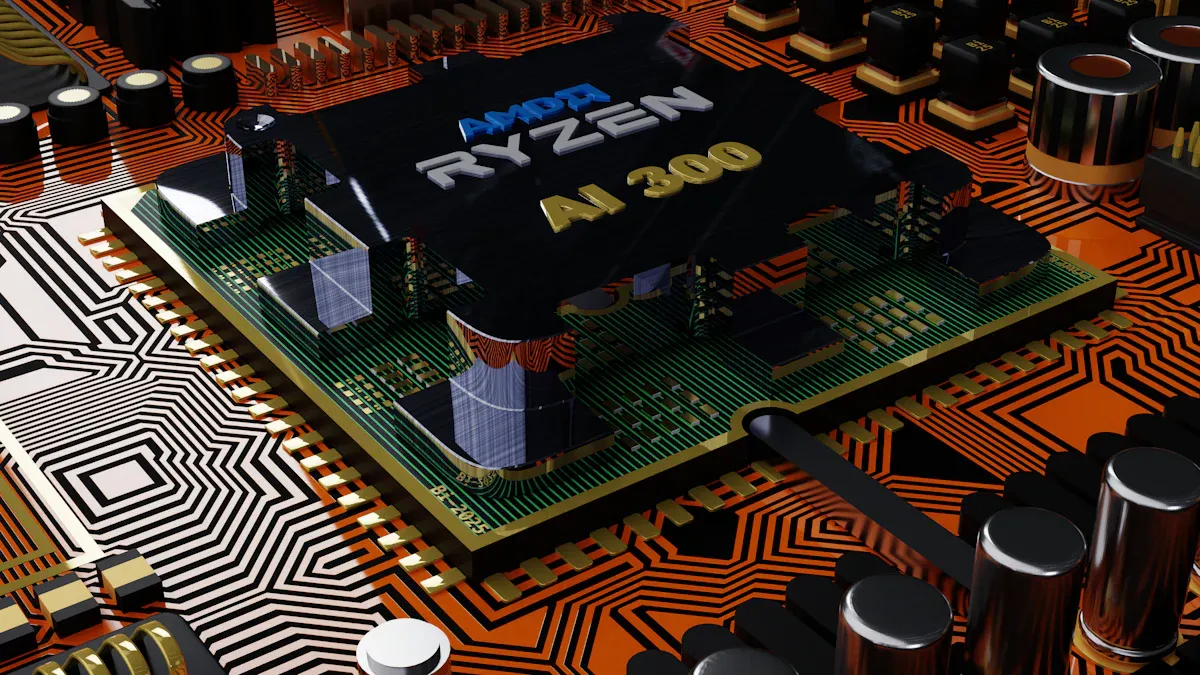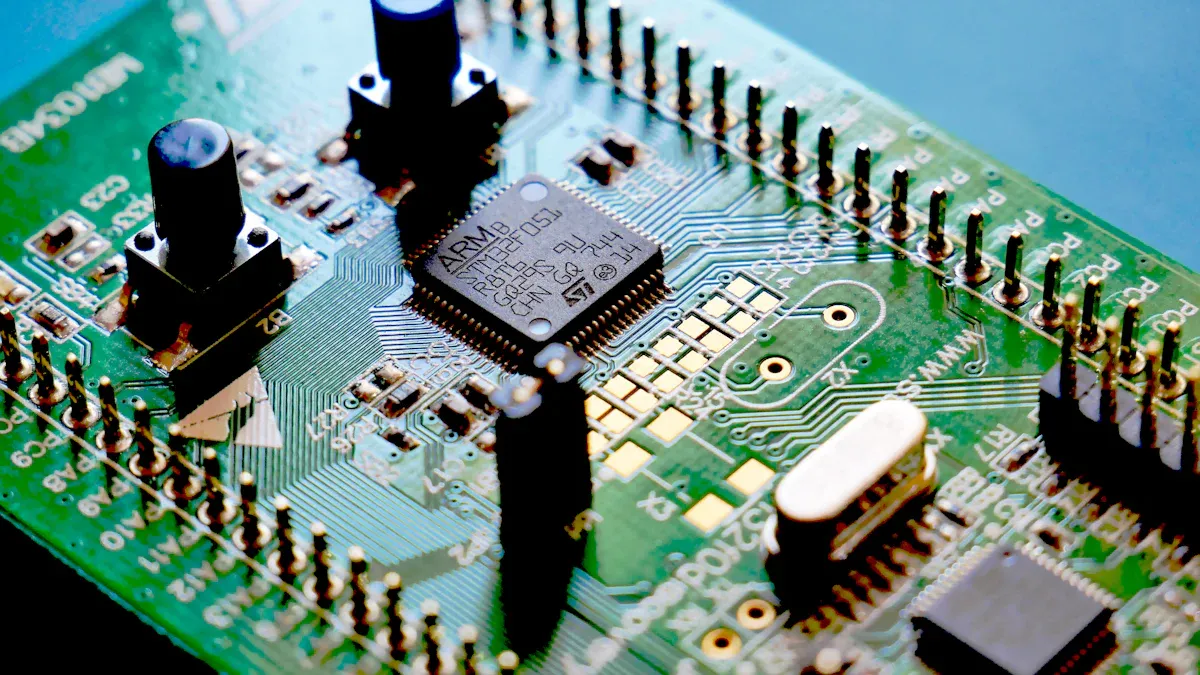What Are Gate Inverter IC Chips and How Do They Work

Gate inverter IC chips play a crucial role in digital electronics. These chips act as digital logic gates, transforming the input signal into its opposite. If the input is high, the output becomes low, and vice versa. You can rely on them for signal inversion, which helps adjust logic levels across circuits. Their ability to reverse signals makes them indispensable for building reliable and efficient digital systems.
Key Takeaways
Gate inverter IC chips flip signals. High signals become low, and low become high. This is important for digital devices.
These chips use NMOS and PMOS transistors to work well. They are dependable for many uses.
Gate inverter IC chips save energy. They lower power use, which helps battery-powered devices last longer.
Their small size fits easily into circuits. This saves space but keeps them working well in modern gadgets.
You can see gate inverter IC chips in many places. They are used in logic circuits, timing circuits, and telecommunications because they are very useful.
What Is a Gate Inverter IC Chip?

Definition and Core Functionality
A gate inverter IC chip is a digital logic device that performs signal inversion. It takes an input signal and produces an output that is its logical opposite. For example, if the input is 0, the output becomes 1, and if the input is 1, the output becomes 0. This behavior aligns with the NOT logic gate, which is fundamental in digital electronics.
To better understand this functionality, consider the following table:
Input (A) | Output (Y) |
|---|---|
0 | 1 |
1 | 0 |
This simple operation is essential for creating complex digital systems. By reversing signals, gate inverter IC chips enable you to manipulate logic levels, ensuring proper communication between different components in a circuit.
Key Components and Design
Gate inverter IC chips rely on transistor technology to perform their function. These chips typically use NMOS and PMOS transistors, which work together to invert input signals efficiently. The design of these chips prioritizes power consumption and speed, making them suitable for a wide range of applications.
Here are some key elements found in gate inverter IC chips:
NMOS and PMOS transistors form the core of the inverter circuit.
Each chip contains multiple inverter circuits, often six, to maximize functionality.
The transistor circuitry is optimized for signal inversion, ensuring reliable performance.
Additionally, inverter chips are versatile. You can use them in logic circuits, timing circuits, memory circuits, amplifiers, and even power electronics. Their compact design allows for easy integration into larger systems, making them a cornerstone of modern digital technology.
Importance in Digital Electronics
Gate inverter IC chips play a vital role in digital electronics. Their ability to invert signals is not just a basic function; it’s a building block for more complex operations. By using these chips, you can construct all other transistor logic gates, such as AND, OR, and NAND gates.
These chips also contribute to system efficiency. Their low power consumption and high-speed operation make them ideal for applications where energy and performance are critical. Whether you’re designing a microprocessor or a communication system, gate inverter IC chips provide the reliability and precision you need.
Tip: When working with digital circuits, always consider the role of gate inverter IC chips. Their simplicity and versatility make them indispensable for signal processing and logic operations.
How Does a Gate Inverter IC Chip Work?
Input-Output Behavior and NOT Logic
A gate inverter IC chip operates based on the principles of NOT logic. You provide an input signal, and the chip produces an output that is the exact opposite. This behavior is simple yet powerful. For example, if the input is high (logic 1), the output becomes low (logic 0). Similarly, when the input is low (logic 0), the output switches to high (logic 1).
This inversion process is essential for digital systems. It allows you to control and manipulate signals effectively. By using gate inverter IC chips, you can ensure that different components in a circuit communicate correctly. This functionality forms the backbone of many digital operations, from basic logic gates to complex microprocessors.
Signal Inversion Process
The signal inversion process in a gate inverter IC chip relies on transistor technology. Inside the chip, NMOS and PMOS transistors work together to reverse the input signal. When you apply a high voltage to the input, the NMOS transistor activates, pulling the output low. Conversely, when the input voltage is low, the PMOS transistor activates, driving the output high.
The IC 7400, a quad 2-input NAND gate, illustrates this process well. By merging the inputs, it functions as an inverter. This capability is crucial in applications like waveform generation, where you need to change the polarity of signals. The chip’s design ensures that the inversion happens quickly and efficiently, making it suitable for high-speed digital systems.
Example of a Gate Inverter in Action
Gate inverter IC chips play a vital role in real-world applications. Their ability to invert signals contributes to the performance of various systems. Here’s a table showcasing some examples:
Application Area | Key Contributors | Performance Outcomes |
|---|---|---|
Three-phase hybrid inverters | Suresh Thangavel, Infineon Technologies | Enhanced efficiency and reduced costs |
Data center AC/DC power supplies | Aparna Kumar, Qorvo | Improved reliability and performance |
Photovoltaic (PV) inverters | Christoph Ihm, Infineon Technologies | Increased sustainability and efficiency |
Heavy-duty electric vehicles | Stephen Oliver, Navitas Semiconductor | High-voltage technology advancements |
DC fast charging for EVs | Didier Balocco, onsemi | Efficiency and reliability enhancements in charging infrastructure |
Data center cooling | Zan Huang, Wolfspeed | Potential for revolutionizing cooling systems |
These examples highlight the versatility of gate inverter IC chips. Whether you’re working on renewable energy systems or electric vehicles, these chips provide the reliability and efficiency needed to achieve optimal performance.
Benefits of Gate Inverter IC Chips
Power Efficiency and Low Energy Consumption
Gate inverter IC chips excel in power efficiency, making them ideal for energy-conscious applications. These chips use dynamic power management to reduce energy consumption. By turning off unused peripherals and optimizing software, they minimize the number of processor cycles required for tasks. This efficiency allows the system to operate in lower-speed, lower-voltage modes or enter standby states faster.
Here’s a table that highlights performance metrics validating their low energy consumption:
Profile Type | Speed/Voltage | Active Mode Duration | Energy Consumption | Standby Mode Duration |
|---|---|---|---|---|
Full-Speed Profile | Full Speed | Short | Lower | Longer |
Reduced-Speed Profile | Lower Speed | Longer | Higher | Shorter |
These features make gate inverter IC chips a cornerstone for systems requiring both performance and energy savings.
High Reliability in Digital Systems
Reliability is a hallmark of gate inverter IC chips. Rigorous testing ensures these chips perform consistently under extreme conditions. For instance, environmental tests like thermal shock and temperature cycling simulate real-world stresses. Even under high temperatures or vibrations, the failure rate remains ≤ 0.1%.
This exceptional reliability makes these chips indispensable in critical applications like automotive systems and industrial equipment. You can trust them to maintain performance even in demanding environments.
Compact and Space-Saving Design
The compact design of gate inverter IC chips allows you to save valuable space in your circuits. Each chip integrates multiple inverter circuits, reducing the need for additional components. This integration not only simplifies circuit design but also enhances portability.
For example, in portable devices like smartphones and wearables, space is at a premium. By using gate inverter IC chips, you can achieve high functionality without compromising on size. Their small footprint makes them a perfect fit for modern, miniaturized electronics.
Tip: When designing compact systems, consider gate inverter IC chips for their ability to combine efficiency, reliability, and space-saving features.
Types of Gate Inverter IC Chips
CMOS Gate Inverters
CMOS (Complementary Metal-Oxide-Semiconductor) gate inverters are widely used in modern electronics. These inverters rely on complementary MOSFET transistors to perform signal inversion. You’ll find them in applications requiring low power consumption and high noise immunity. For example, the CD4069 CMOS inverter operates over a broad voltage range (3–15V) and offers excellent noise resistance, making it suitable for both analog and digital circuits.
One key advantage of CMOS inverters is their efficiency. They draw almost no static power when idle, which helps conserve energy in battery-powered devices. However, their performance can degrade due to gate oxide breakdown, which increases current leakage and affects circuit reliability.
Property | Description |
|---|---|
Output Voltage | Drives output to 0 (ground) or VDD for logical 0 or 1 |
Power Dissipation | Consumes minimal power due to zero static current at equilibrium |
Inverting Functionality | Implements only inverting functions like NOT, NAND, and NOR gates |
Popular CMOS gate inverter ICs include:
74HC04: High speed and low power consumption for general digital applications.
74HCT04: Features Schmitt trigger inputs for noise-resistant signal processing.
TTL Gate Inverters
TTL (Transistor-Transistor Logic) gate inverters use bipolar junction transistors (BJTs) to achieve signal inversion. These inverters are known for their fast switching speeds, making them ideal for time-sensitive applications. However, they consume more power compared to CMOS inverters and typically operate at a fixed voltage of 5V.
The 74LS04 is a common TTL inverter IC. It offers reliable performance in circuits where speed is critical. While TTL inverters have lower noise immunity than CMOS, they can be optimized to handle specific noise challenges.
Feature | TTL Hex Inverters |
|---|---|
Technology | Uses bipolar junction transistors (BJTs) |
Power Consumption | Higher than CMOS |
Voltage Range | Fixed at 5V |
Noise Immunity | Lower than CMOS but can be improved with design adjustments |
Key Differences Between CMOS and TTL
When choosing between CMOS and TTL gate inverters, you should consider their distinct characteristics. CMOS inverters excel in power efficiency and noise immunity, while TTL inverters offer faster switching speeds. The table below highlights their key differences:
Characteristics | CMOS | TTL |
|---|---|---|
Voltage Levels | Fixed at 5V | |
Power Consumption | Low | High |
Technology | MOSFET | Bipolar Junction Transistor (BJT) |
Noise Immunity | High | Low |
Fan-Out Capability | High | Lower |
Speed | Slower propagation delays | Faster propagation delays |
By understanding these differences, you can select the right gate inverter IC chip for your project. For energy-efficient designs, CMOS inverters are a better choice. If speed is your priority, TTL inverters may be more suitable.
Applications of Gate Inverter IC Chips

Use in Digital Logic Circuits
Gate inverter IC chips are essential for digital logic circuits. You can use them to create basic logic gates like NOT, NAND, and NOR. These gates form the foundation of digital systems, including microprocessors and memory units. By inverting signals, the chips help you control the flow of data and ensure accurate operations.
For example, in a binary counter circuit, gate inverters flip the logic levels to enable counting. This process ensures that the circuit performs arithmetic operations correctly. You can also use these chips to simplify complex logic designs, reducing the number of components needed in your circuit.
Role in Timing and Oscillator Circuits
Timing and oscillator circuits rely heavily on gate inverter IC chips. These chips help you generate precise clock signals, which are crucial for synchronizing operations in digital systems. By inverting signals, they create oscillations that drive timing circuits.
A common application is in square wave generators. Gate inverters produce alternating high and low signals, forming a square wave. This wave serves as a clock signal for devices like microcontrollers and digital watches. You can also use these chips in delay circuits to control the timing of signal propagation.
Tip: When designing timing circuits, choose gate inverter IC chips for their reliability and precision. They ensure your system operates smoothly and accurately.
Applications in Signal Processing and Telecommunications
Signal processing and telecommunications benefit greatly from gate inverter IC chips. These chips help you manipulate and transmit signals effectively. For instance, in signal amplifiers, gate inverters adjust the polarity of input signals to enhance their strength.
In telecommunications, you can use gate inverters for encoding and decoding data. They invert signals to match the required logic levels, ensuring seamless communication between devices. Gate inverter IC chips also play a role in noise reduction, improving the clarity of transmitted signals.
Whether you’re working on audio processing or wireless communication systems, these chips provide the functionality you need to achieve optimal performance.
Gate inverter IC chips are essential components in modern electronics. They invert input signals, enabling precise control in digital systems. Their benefits include high efficiency, fast switching, and reliable thermal performance. You can use them in various applications, from logic circuits to telecommunications.
Feature | Description |
|---|---|
High Efficiency | Inverter MOSFETs are designed for minimal energy loss during switching, enhancing overall system efficiency. |
Fast Switching Speed | Optimized for rapid transitions, reducing transition losses and improving performance in high-frequency applications. |
Low On-Resistance (R_DS(on)) | Lower on-resistance minimizes conduction losses, making them suitable for high-current applications. |
Explore how these versatile chips can simplify your designs and improve system performance.
FAQ
What is the primary purpose of a gate inverter IC chip?
A gate inverter IC chip reverses the input signal. If the input is high (1), the output becomes low (0), and vice versa. This function helps you manage logic levels in digital circuits, ensuring proper communication between components.
How do CMOS and TTL gate inverters differ?
CMOS inverters consume less power and work across a wide voltage range. TTL inverters operate faster but use more energy and require a fixed 5V supply. Choose CMOS for energy efficiency and TTL for speed-sensitive applications.
Can you use gate inverter IC chips in timing circuits?
Yes, you can use them in timing circuits. They generate precise clock signals by inverting input signals. These signals synchronize operations in devices like microcontrollers, ensuring accurate performance.
Are gate inverter IC chips suitable for portable devices?
Absolutely! Their compact design and low power consumption make them ideal for portable devices like smartphones and wearables. They save space while maintaining high functionality.
What are some common gate inverter IC models?
Popular models include the 74HC04 (CMOS) for low-power applications and the 74LS04 (TTL) for high-speed circuits. Both are reliable and widely used in digital systems.
Tip: Always check the voltage and power requirements of your circuit before selecting a gate inverter IC chip.
See Also
Exploring Optocoupler IC Chips: Functionality and Applications
Battery Charge Controller ICs: Their Function and Importance
Industrial Control Chips: Role and Function in Automation
Understanding Communication Chips: Their Functionality and Use
Battery Charger Controller ICs: Understanding Their Functions
